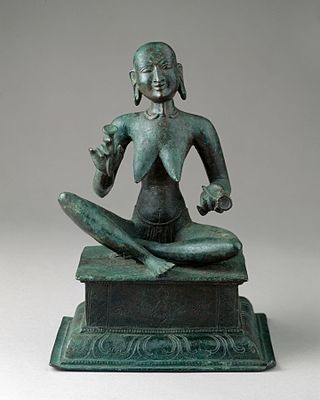Top Qs
Timeline
Chat
Perspective
Karaikkal Ammaiyar
Major figure in early Tamil literature From Wikipedia, the free encyclopedia
Remove ads
Karaikal Ammaiyar (born Punītavatī), meaning "The Revered Mother of Karaikal", is one of the three women amongst the 63 Nayanmars and one of the greatest figures of early Tamil literature. She was born in Karaikal, South India, and probably lived during the 5th century CE.[1] She was a devotee of Shiva.[2][3]

Remove ads
Early life

Karaikal was a maritime trading city in Chola Nadu. Ammaiyar, whose original name was Punitavati, was born to Dhanadattan in a merchant community known as Chettiar, popular tradition linking it with the Nattukottai Nagarathar community (also known as Nattukottai Chettiar).[4][5][6] She was married to Paramadattan, a wealthy merchant from Nagapattinam. Mangani festival in Karaikal is an annual event celebrated in honor of Karaikal Ammaiyar [7]
Works
She was the first known one whom used the Andādi concept of literature, (Arpudath Tiruvandaathi). She also wrote Tiruvaalangaadu Tiruppadhigam and Tiruvirattai Manimaalai which symbolises the devotion towards lord Shiva, she was considered as the foremost among Bhakti saints to contribute to the devotional literature and its growth.
Remove ads
Ammaiyar Image in Cambodia
Banteay Srei or Banteay Srey (Khmer: បន្ទាយស្រី [ɓɑntiəj srəj]) is a 10th-century Cambodian temple dedicated to the Hindu god Shiva. Located in the area of Angkor, it lies near the hill of Phnom Dei, 25 km (16 mi) north-east of the main group of temples that once belonged to the medieval capitals of Yasodharapura and Angkor Thom.[8]
The second enclosure
The inner enclosure wall has collapsed, leaving a gopura at the eastern end and a brick shrine at the western. The eastern pediment of the gopura shows Śiva Nataraja; the west-facing pediment has an image of Karaikal Ammaiyar, one of the three women saints amongst the sixty three Nayanmars (hounds of Śiva).[9]
Remove ads
Notes
References
External links
See also
Wikiwand - on
Seamless Wikipedia browsing. On steroids.
Remove ads


